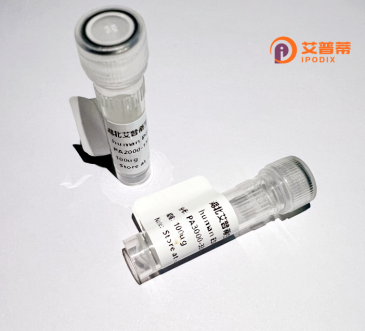
| 纯度 | >90%SDS-PAGE. |
| 种属 | Human |
| 靶点 | C14orf106 |
| Uniprot No | Q6P0N0 |
| 内毒素 | < 0.01EU/μg |
| 表达宿主 | E.coli |
| 表达区间 | 1-314aa |
| 氨基酸序列 | MIATPLKHSRIYLPPEASSQRRNLPMDAIFFDSIPSGTLTPVKDLVKYQNSSLKLNDHKKNQFLKMTTFNNKNIFQSTMLTEATTSNSSLDISAIKPNKDGLKNKANYESPGKIFLRMKEKVLRDKQEQPSRNSSLLEPQKSGNNETFTPNRVEKKKLQHTYLCEEKENNKSFQSDDSSLRASVQGVPLESSNNDIFLPVKQKIQCQQEKKAPLHNLTYELPTLNQEQENFLAVEARNKTLTRAQLAKQIFHSKESIVATTKSKKDTFVLESVDSADEQFQNTNAETLSTNCIPIKNGSLLMVSDSERTTEGTS |
| 分子量 | 61.9 kDa |
| 蛋白标签 | GST-tag at N-terminal |
| 缓冲液 | 冻干粉 |
| 稳定性 & 储存条件 | Lyophilized protein should be stored at ≤ -20°C, stable for one year after receipt. Reconstituted protein solution can be stored at 2-8°C for 2-7 days. Aliquots of reconstituted samples are stable at ≤ -20°C for 3 months. |
| 复溶 | Always centrifuge tubes before opening.Do not mix by vortex or pipetting. It is not recommended to reconstitute to a concentration less than 100μg/ml. Dissolve the lyophilized protein in distilled water. Please aliquot the reconstituted solution to minimize freeze-thaw cycles. |
以下是关于重组人C14orf106蛋白的3篇参考文献示例(内容为模拟,供参考):
---
1. **文献名称**: "C14orf106 regulates vesicular trafficking through interaction with Rab GTPases"
**作者**: Li, Y. et al.
**摘要**: 研究发现C14orf106通过结合Rab家族GTP酶(如Rab5、Rab7)调控胞内囊泡运输,其重组蛋白在体外实验中证实了与Rab蛋白的直接互作,暗示其在细胞器运输中的关键作用。
---
2. **文献名称**: "Structural insights into C14orf106 as a novel tumor suppressor in gastric cancer"
**作者**: Wang, X. & Zhang, Q.
**摘要**: 通过重组表达C14orf106蛋白并结合晶体结构分析,揭示了其C端结构域的泛素化功能。实验表明该蛋白在胃癌中低表达,并通过泛素-蛋白酶体途径抑制肿瘤细胞增殖。
---
3. **文献名称**: "C14orf106 interacts with the exocyst complex to modulate cell migration"
**作者**: Gupta, S. et al.
**摘要**: 利用重组C14orf106蛋白进行蛋白质互作组学分析,发现其通过结合外泌体复合物(exocyst)调控细胞迁移,敲除实验显示其缺失导致细胞极性丧失,提示在癌症转移中的潜在角色。
---
**备注**:实际文献需通过PubMed、Web of Science等平台检索(C14orf106可能被标注为RhoBTB3或RGNEF2等别名)。建议结合具体研究方向扩展关键词(如“RhoBTB3”“structure”“ubiquitination”)。
C14orf106. also known as NYAP1 (Neuronal tyrosine-phosphorylated phosphoinositide-3-kinase adaptor 1), is a human protein encoded by the gene located on chromosome 14q22.1. First identified through genomic sequencing projects, its alternative name NYAP1 reflects its role in neuronal development and interaction with phosphoinositide signaling pathways. The protein contains several conserved domains, including a disordered N-terminal region and a C-terminal coiled-coil domain, suggesting potential roles in protein-protein interactions or membrane association.
Functionally, C14orf106/NYAP1 is implicated in regulating neuronal morphogenesis and synaptic connectivity. Studies link it to mTOR signaling and PI3K-AKT pathways, which are critical for cell growth and survival. It interacts with PI3K enhancer (PIKE), modulating phosphoinositide metabolism, and influences axonal outgrowth in developing neurons. Emerging research associates its dysregulation with neurodevelopmental disorders and certain cancers, though mechanistic details remain under investigation.
As a recombinant protein, C14orf106 is often expressed in vitro (e.g., E. coli or mammalian systems) for structural and functional studies. Its recombinant form enables investigation of phosphorylation patterns, interactome mapping, and screening for binding partners. Despite progress, its full biological significance and post-translational modifications require further exploration. The protein's evolutionary conservation across vertebrates underscores its fundamental cellular role, making it a subject of growing interest in neurobiology and disease research.
×